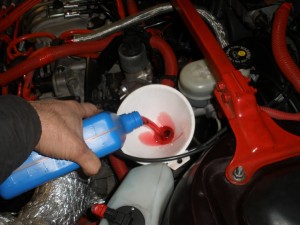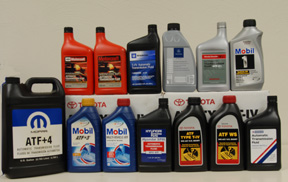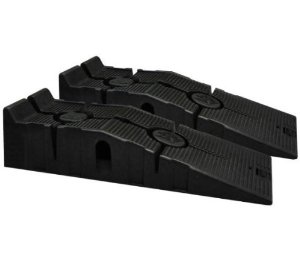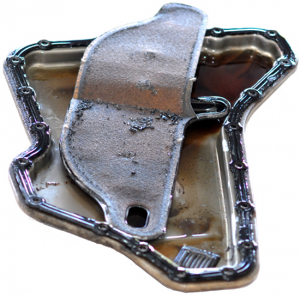A do-it-yourself transmission fluid change is an affordable way to maintain and lengthen your vehicle’s performance and lifetime and it will save you from waiting at a service station and listening to a mechanic try to sell you additional services that your doesn’t need.
What Transmission Do I Have?

To avoid transmission problems, you should check the level and condition approximately once a month using the dipstick. If the color is bright red and it smells sweet, it is still usable, but if it is darker, dirty and/or smells burnt, change it. If the level is low, top it up and check for leaks.
In This Guide
When to Change Transmission Fluid
It is often recommended that you change the fluid in your car every 30,000 to 60,000 miles (see your owner’s manual for the specific advised maintenance schedule).
The frequency should change depending on how tough you are on your transmission and how severe the conditions you drive in are. Tougher conditions include trailer towing, extended high speed driving and driving in cold weather require more frequent changes (every 15,000-24,000 miles give or take).
For automatic transmissions, some manufacturers recommend that the fluid be only changed every 60,000 to 100,000 miles. To tell how hard you’re being on your gearbox, you can install a temperature gauge.
How Much Does it Cost?
 The cost of having your fluid changed at a dealer, service center or independent mechanic ranges from $80-$250. The average is around $100.
The cost of having your fluid changed at a dealer, service center or independent mechanic ranges from $80-$250. The average is around $100.
A do it yourself oil change typically cuts the price in half (at least), and it’s as easy as following a few simple steps as outlined below. To change the fluid yourself, it will cost around $40 to $90 for the filter, gasket and the most important component – the transmission oil. This estimate does not include the cost of the tools required to do the job.
Note: A transmission flush is a different process and typically costs around twice as much as a change.
How to Check
To check to see if your vehicle needs an oil change, simply:
- Turn on your car and let it run a few moments (It is always best to check your oil when it has had time to warm up).
- Wipe the dipstick with a clean cloth or rag; then put it back in and take it out again.
- If the oil is clear but at the low mark, pour in enough fluid to bring it up to the appropriate level. Don’t overfill!
- If the fluid is very dark or smells burnt, it need to be changed. Good clean oil should be bright red/pink in color.

Tools You Will Need
- Fluid – Check your vehicle’s owner’s manual to tell you how many quarts, and the specific type you will need, or speak to a representative at the auto parts store.
- Filter – Check to make sure you get the correct size and quality.
- Torque Wrench – If you don’t have one, don’t fret. A normal socket wrench set will suit you just fine.
- Large pan to catch the fluid – you don’t want to get it on the ground or in the dirt. Try to get one that is larger than the pan (casing) as it will leak out from all sides.
Instructions
Put Your Car on Ramps
 Start by putting your car up on ramps, or jacking up the front part of your vehicle, while using jackstands. Don’t forget to block the wheels. Put old clothes on, this will get kind of messy. You may also want to put newspaper underneath where you will be working so no oil will get on your driveway. It is also very important to dispose of it properly once you are finished. Many auto parts stores either have a place where you can dump the oil, or can tell you how to dispose of it properly. It is not recommended that you empty it in your trash or in your yard.
Start by putting your car up on ramps, or jacking up the front part of your vehicle, while using jackstands. Don’t forget to block the wheels. Put old clothes on, this will get kind of messy. You may also want to put newspaper underneath where you will be working so no oil will get on your driveway. It is also very important to dispose of it properly once you are finished. Many auto parts stores either have a place where you can dump the oil, or can tell you how to dispose of it properly. It is not recommended that you empty it in your trash or in your yard.
Find the Transmission Pan
Locate the transmission pan with the help of your owners manual. Put the oil pan that you will use directly underneath. Remove the bolts slowly and keep your face out of the way. Once the seal is broke on the bolts, the fluid will start dripping out. Put the bolts to the side and let the oil drain completely into the drain pan. Wash the sediments and deposits out of the pan using fluid, not water. Inspect the debris that was in the pan. Doing so can help you determine whether the transmission is running properly or if there is a impending problem in the near future. This can be difficult for the untrained eye to do, so in the words of an ASE Certified Master Automotive Technician (CMAT): “You should see next to no filings or debris, and then only on the first change, subsequent changes should be nearly dead clean. If your car is relatively new and you find debris, there is a problem. You might find just a trace of aluminum shavings, or other very minor contaminants, but the assembly process is so clean, and the newer gearboxes so unforgiving of dirt, that any real accumulation generally means a problem is in development.”

Check the Gasket
Check to see if you need to replace the gasket. If it is well worn, go ahead and replace it. It will save you repair further down the road. Apply a thin layer of RTV sealant to the pan’s flange to ensure a nice tight, leak proof seal.
Remove the Filter
Once it has drained completely, remove the filter. Take caution, the filter has fluid in it as well. Replace it with your new filter, and tighten to the specifications in your owners manual. Then replace the bolts on the pan, tighten them for the first couple threads by hand before using a tool. Now you are ready to add the fresh oil. A funnel is recommended, hardly anyone can do this without spilling.
What Transmission Do I Have?

Once you have completed your oil change, start the car up and let it run a few minutes. Shift your gears a few times, then put in back in park. Now you can check the dipstick. Pull the dipstick out, wipe it on a clean rag, reinsert it, and pull it out again. Hold it level and check to see where the oil is sitting on the stick. It should be sitting on the correct line, usually saying full. Once this is complete, you are ready to take it off the ramps, or let it down from the jack. Then give yourself a pat on the back. You just changed your own fluid and saved money!

Why wont my gears shift its stuck in park does that meen theres no fluid in it chrysler 300 2006
It probably has a shift sensor. I had this problem once. When you apply the brake to shift into gear. There’s a sensor that tells the shifter that the brake has been pushed allowing it to shift. Sometimes the sensor gets stuck or isn’t making a good connection. Try looking for it and use your finger to push the button on the sensor. If you don’t hear the click sounds . It probably isn’t working
The Nissan versa note doesn’t have a dip stick nor does it it shows you how to get to the changing if it
Many modern transmissions are “sealed for life” (never true) so no dipstick. You usually have to remove the transmission pan to drain and they may have a fill hole under the car as well and usually require a hand pump to fill, like a rear differential. I’m sure you can find a how to for your specific car or at least a shop manual with some google searches.
My Nissan Navara 2010 model, has a problem with the transmission,the gears changes from first,second and third but the rest Will not change.
Please i need assistance how to solve that problem.
Thank you.
The 2015 Ford Focus Dual Clutch automatic transmission #DPS6 does not have a dipstick. Nor do late model automatic transmission Mustangs.
How much will it cost me to have my transmission fluid and filter changed on a 2002 V6 automatic Mustang?
$150 cd
In this article we have already an idea on how to avoid transmission problems. It is important to check the level and condition approximately once a month using the dipstick. If the color is bright red and it smells sweet, it is still usable, but if it is darker, dirty and/or smells burnt, change it. If the level is low, top it up and check for leaks. Glad to read this article.
after changing fluid,and both filters in my 2000 jeep grand Cherokee it won’t shift into any gear this is a automatic transmission.never seen this before even let it run in neutral for a while trying to prime up the torque convertor got any ideals.
I have a hyundai coupe 1.6 2005 lately it’s been making some strange noises. When I prest clutch down it sometimes makes a loud squeak that doesn’t stop until you take your foot off. Today I left my foot on the clutch for abit longer and it’s making a grinding noise like it’s crushing something up. It goes into gear fine & drives ok but worried it might give up soon. I can’t get my head around it. Any thoughts or ideas ?
I was flushing the transmission for a Chevy e 300 because the tank in the radiator burst mixing water. The first flush was a white sticky substance. After about 3-4 flushes it became a pink colour. Do I have to flush again to get the same color fluid I’m pouring in? Or that should be straight right now?
If the Sedona is like the Borrego, there is NO dipstick on the tranny. Seems Kia would rather have you just trust!!
I need to know how to change the transmission fluid in my 2011 Kia Sedona?
It doesn’t have a dip stick
I can’t find anywhere I can add fluid
there is a dipstick under the hood somewhere….check your owners manual….and you will need to put new oil in through that dipstick hole….you will most definitely need a funnel with a small spout
Most new transmissions are sealed. There is a fluid level bolt somewhere on the side of the tranny and a fill bolt somewhere on top. Either take it to a mechanic or check you tube to see if someone posted a vid on your vehicle.
How is the consumer going to check the transmission fluid without a dip stick? Why are car manufactors producing these types of vehicles? Please help.
Sounds like I could do it…all but the “Ramp” part!!? Being new at this, and a Woman, I’m not quite confident or sure as to how to go about putting Car on Ramps? And Safely? Could someone explain this part a little more in detail? Thanks!
Hi Katie, thanks for the comment! You’ll need a pair of car ramps to drive your car onto so that the front end is raised and you can access the transmission pan. I’ve added a picture as an example in the article. You can get them on Amazon: http://amzn.to/22sD0ZR
Here’s a great instructional video on YouTube: https://www.youtube.com/watch?v=d1-Dp9w0x78
Hope this helps!
My auto prelude clutch is slipping a lot, what can I do to fix this problem? And I don’t know if it’s the clutch or the transmission fluid is low.
I have a Nissan Xterra 2006 Model. I intend to change the transmission oil and I was advised to leave the car overnight before changing the oil first thing in the morning (before switching on ignition) to a avoid damage to the transmission system if the fluid is drained after driving.
Please, is this true? does is means I can drained the ATF immediately after driving?
Thanks.
Sam
So how much Oil you put in the transmition??? Honda civic 2005
Check YouTube all I did was look up how to change the oil went figured out which parts I need to buy went to the auto parts store bought my T.O. filter bought the gasket that fits my 06 Sierra lifted up my truck with a jack, Jack stands, blocked the rear tires and went at it just like the video showed took off all the screws had to pry the oil pan off with a screw driver let it leak pulled it off wiped the inside cleaned the pan replaced the gaskets screwed the pan back in don’t forget to replace the transmission oil check your owners manual or ask the attendant to look it up at the parts store they will be able to help you as for me I had to purchase high mileage T.O.
My question is how much would it cost to change transmission fluid on a 2002 cadillac???
My Golf 2 VW automatic can’t shift gears, I change transmission but it still don’t shift gears, please help.
Does anyone have any ideas on how to add transmission fluid from home in my 2005 ford explorer it’s the kind u have to crawl underneath an check/add the fluid. Thanks
yes. you put a pump hose on a quart of oil and handpump the oil while underneath the explorer.
I have a 1995 Toyota Estima Van. I just got this vehicle. Anyway after driving it for a few weeks, one morning I started it up and placed it in reverse and it did not go at all. After a couple of seconds, it seemed to get into gear and then I drove it to a mechanic. It was low on transmission fluid and I had a mechanic put a liter or so into it as I also scheduled an oil changed. Okay for the next 1000 miles it was doing fine but lately it started again. This time it is not low with transmission fluid as far as I can tell. I know it is a used vehicle and that I have no way of knowing the last time the AT was checked. Could it be a clogged filter? Once it is on the road, it runs fine and shifts fine and the OD is also working great. I don’t smell the ATF as burnt or a dark color. Let me know. TL
Yeah my 87 f350 does that too, but otherwise it is fine. Not sure what the problem is…